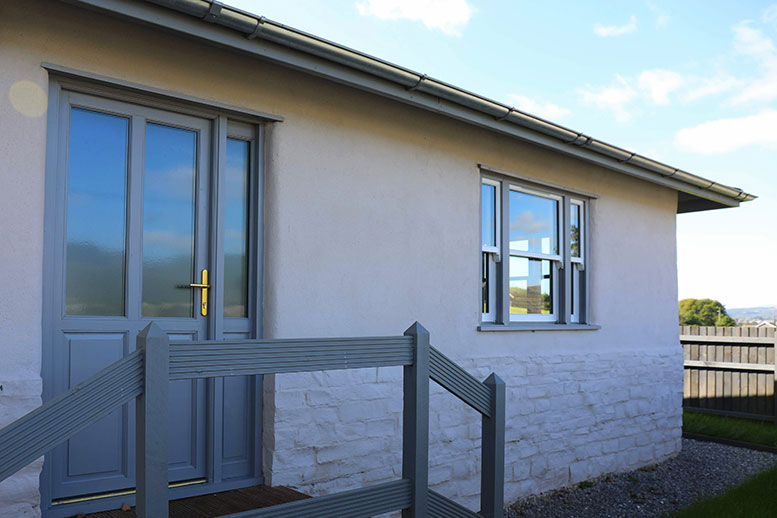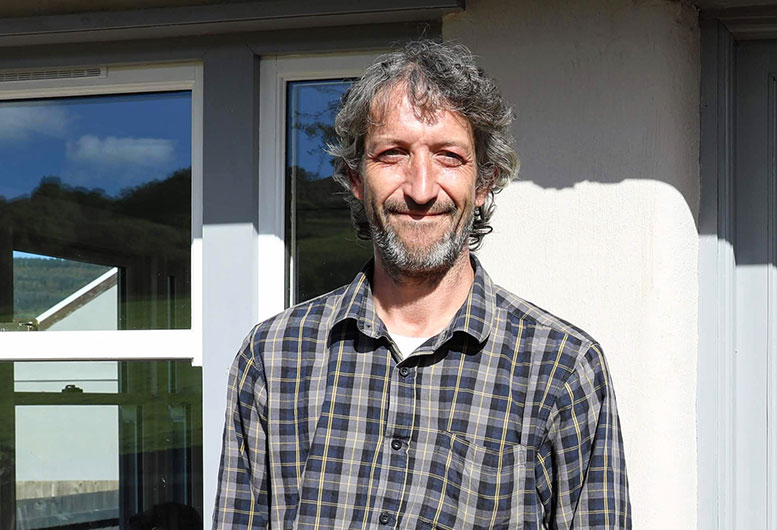By Andi Lucas
My visit to The Hemp Bungalow in the small town of Aberdare in the Welsh valleys began with my feeling that I must not have the right address.
The 1950s bungalow-style cottage is tucked away on the winding Brynheulog Terrace and has the feeling of a home that has been in place for many years, sitting solidly on its Welsh pennant sandstone plinth, as is traditional for this region. Upon entering the front door, my first impression was reinforced as the modest home has a very established and peaceful feel for a property that was still having the final finishing touches added by master builder Grant Avon, 41, of Avon & Co Building Consultants Ltd.

Avon was briefed to design and build the three-bedroom, two-bathroom 87m² / 936 ft² house on a greenfield site by David Naydorf – a longtime family friend and former business partner of Avon’s grandfather – and Naydorf’s son Leon. Given that his client was seeking a quality build and was open to using environmentally friendly materials, and having had success with an experiment using hempcrete on a small section of his own home about four years ago, Avon saw an opportunity to undertake what he describes as the first commercially available building in Wales constructed using hempcrete.
The level of care that has been taken with both the building method and materials choice was apparent everywhere I looked. As is common in the United Kingdom, the structure has been built on a standard strip foundation with blockwork to the damp-proof course and has a regular timber frame, however Avon was able to gain a cost-saving on the build by using slightly smaller-than-average lumber due to the stabilizing nature of the hempcrete material that is packed around the studs.
Meeting codes
Using hempcrete did not require Avon to give special consideration to the plumbing or electrical work. The building has been constructed to meet the tough Welsh planning codes which go as far as demanding interior sprinkler systems as standard on all new residential builds, meaning that the high-cost items in the client’s budget would have been incurred regardless of the choice to use a carbon-negative material like hempcrete.
According to the Architecture 2030 Project, the “…hempcrete wall system transmits humidity, is fireproof, deters insects and rodents, resists mold (can recover from water penetration without molding), has excellent acoustic performance, is recyclable, has no VOC or other toxins, and can endure for centuries”, all of which being highly appealing qualities for any builder, client, or homeowner. While Avon would have preferred not to use any concrete, he was able to slightly offset the impact of the poured floor by using 160mm of Glapor recycled foamed glass gravel in the foundations, and by finishing with a combination of engineered bamboo, carpet and tile.
All of the timber joinery was custom made by Avon’s father Nick in a new factory workshop set-up in nearby Ferndale, and the beautifully made wooden window frames with traditional brass fixtures plus the galvanized gutters give The Hemp Bungalow a solid and traditional look-and-feel. The roof is recycled rubber ‘eco-slate’, which is in keeping with the local aesthetic, and the lime-washed and rendered exterior along with the absence of PVC and other plastics adds to the feeling that this brand new home had been in situ for a long time.
Avon purchased the hemp-lime plaster from Ty-Mawr Lime Ltd, a supplier based in nearby Brecon, and as there was no hydraulic lime at the local hardware store, was buying pre-mixed 25kg bags of lime putty which was “…knocked up” with a bit of water before being mixed with the woody inner part of the hemp stalk, known as hurd or shives. The hurd was sourced directly from a private farm in East Yorkshire owned by grower Nick Voase, with a retail cost sitting at around GBP£11 / USD$13.50 for a 180-litre bag, and a French, lime-based binder was used in the mix.
Although Avon quite liked the look of the walls in their natural state, the client wanted a different color scheme so a clay-based paint made by Earthborn was applied. While this environmentally friendly and breathable material cost about 40% more than the least expensive products on the market, Avon estimates that the paint price came in at around the same as premium interior house brands. Following the conventional wisdom that hempcrete cures best when the temperature range is between 5°C and sub-30°C or 40°F to sub-85°F, Avon noted that he believes other builders are also having success in cooler temperatures. As hempcrete should apparently not be exposed to direct sunlight during the drying period, there was a small additional cost in materials and labor attaching protective hessian sheets to the facia, an extra step in the construction process that Avon describes as having very little negative impact.
The hemp is insulation
For home builders or professional tradespeople comfortable with plastering who are aware that hempcrete has different properties to their usual material choice and can’t be treated as cement, or for stonemasons who already understand lime and breathability, Avon sees no reason why hempcrete can’t become a much more commonly used material in both new builds like The Hemp Bungalow and restoration work in the many stone-built structures found in Wales specifically, and more broadly through the United Kingdom and Europe. While one challenge lay in finding appropriate indemnity insurance for the necessary 10-year warranty, this requirement was satisfied by describing the structure as a timber frame house with hempcrete insulation, which met the insurers’ criteria and meant a policy could be secured.
According to Avon, outside of his extensive building experience, there were no hempcrete-specific skills or advanced training required to complete the project beyond needing greater patience with the drying time. It was between six-to-eight weeks before the walls were ready for plaster, and another two-to-three months for the plaster itself to fully dry. While the most complicated aspect of the build was the formwork, once the shuttering was up, the process of mixing and packing the hempcrete took three people three weeks to complete with what Avon describes as “…DIY level” building experience required. Avon used sections of PVC piping to create easy rounded shuttering in the window frames. More work was involved in the creation of a large, curved wall in the master bedroom, an effect that was achieved by time consumingly manually packing the material into smaller shuttering and forming the rounded shape by hand.
The passion Avon feels for bringing truly sustainable building practice into the commercial construction industry is evident. In his role as a lecturer teaching Sustainable Construction at Coleg y Cymoedd (College of the Valleys), Avon wants his students to understand that when it comes to environmentally friendly building methods, it is always “…materials first”, and in his view, the benefits of using hempcrete far outweigh any of the costs of the additional drying time or logistical challenges dealing with planners or insurance providers who aren’t educated or familiar with the product.
For me, learning more about the hempcrete-specific factors that need to be considered when using this method rather than relying on more readily available and commonly used modern materials is one of the most important and interesting aspects as I seriously consider using hempcrete on my upcoming commercial property development projects. The more I learn about hempcrete, the more confident I am making vastly more ecologically sound building choices going forward. I feel lucky to have been able to visit The Hempcrete Bungalow, and even more fortunate to be able to meet builders like Avon and other passionate and skilled hempcrete advocates around the world who are so willing to share their knowledge of the process.

Freelancer Andi Lucas is the founder and owner of NSP Development. After a decade running start-up businesses in Colorado, USA, she is currently working her way back to her native home of Tasmania, Australia with stops in 15 cities in the USA, UK, Japan and Costa Rica. This four-month-long period of travel is providing opportunities to meet with many passionate people working in the industry, exploring everything she can about hemp and writing about what she has learned along the way.

